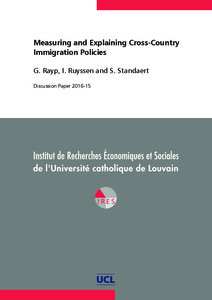Measuring and explaining cross-country immigration policies
"The intensified international migration pressures of the recent decades prompted many developed countries to revise their immigration regulations and increase border controls. However, the development of these reforms as well as their effectiveness in actually managing new immigration flows re...
| Main Authors: | , , |
|---|---|
| Institution: | ETUI-European Trade Union Institute |
| Format: | TEXT |
| Language: | English |
| Published: |
Louvain-la Neuve
2016
UCL |
| Subjects: | |
| Online Access: | https://www.labourline.org/KENTIKA-029312484759-Measuring-and-explaining-cross.htm |
| Summary: | "The intensified international migration pressures of the recent decades prompted many developed countries to revise their immigration regulations and increase border controls. However, the development of these reforms as well as their effectiveness in actually managing new immigration flows remains poorly understood. The main reason is that migration regulations are hard to quantify, which has prevented the construction of a universal measure of migration policy. To fill this gap in the literature, we construct an indicator of the restrictiveness of immigration entry policy across countries as well as a more comprehensive indicator of migration policy that also accounts for staying requirements and regulations to foster integration. These indexes are then used to disentangle the factors determining the toughness of migration regulations. Our empirical framework combines elements from the median voter and interest group approach and accounts for cross-country correlation in migration policies. We find strong evidence of spatial correlation in particular in entry restrictiveness, while the impact of economic determinants of migration policy remains much more modest." |
|---|---|
| Physical Description: | 36 p. Digital |

